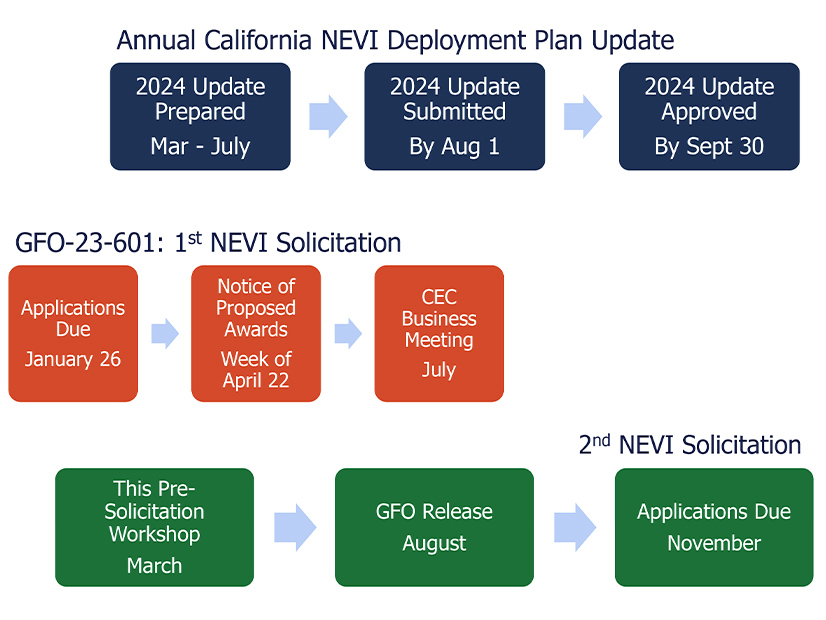
California officials are exploring how to improve the process for dispensing hundreds of millions in federal funding to construct a public network of electric vehicle charging stations.
California officials are exploring how to improve the dispensation of hundreds of millions in federal funding to build a public network of electric vehicle charging stations.
At a March 12 workshop, officials from the state’s Energy Commission (CEC) and Department of Transportation (Caltrans) sought feedback on how dispensation worked during the first round of grant solicitations from the National Electric Vehicle Infrastructure (NEVI) program, which aims to build a national network of chargers to encourage EV uptake.
A part of the federal Infrastructure Investment and Jobs Act (IIJA), NEVI will provide $5 billion to states to build 500,000 direct current (DC) fast chargers that will enable data collection, reliability and long-distance travel in zero-emissions vehicles. California’s share of the funding is expected to be $384 million allocated over five years (See Federal Plans to Electrify Highway Corridors Advancing.)
The first tranche of funding was released in October 2023 and awards are expected to be granted in late April. The second round of funding is slated to be released in August, and applications are due by November to the Joint Office of Energy and Infrastructure.
The workshop provided an opportunity for the CEC and Caltrans to present and solicit feedback on the proposed structure and requirements for the second NEVI grant funding opportunity based on comments received about the first solicitation.
Structure of the Plan
EV charging projects must meet basic requirements to be eligible for NEVI funding. Key among them is the requirement for stations to be publicly available, located no more than one mile from a highway designated as an “alternative fuel corridor” and placed no more than 50 miles apart from each other. The stations also must contain at least four DC chargers of at least 150 kW per port.
Under the 2023 California NEVI Deployment Plan, designated highway corridors are broken into segments containing one or more charging stations. Groups of corridor segments then are identified by geography and ranked to fund the highest-priority areas first. Only private entities, including investor-owned utilities, are eligible to bid into the competitive solicitations to build, own and operate charging stations.
Speaking at the workshop, Jane Berner, strategic investment analyst at the CEC, identified 21 corridor groups in California ranked by characteristics that determine whether the segment is high-priority, including the percentage of the corridor located in a disadvantaged or low-income community, the number of chargers needed along the corridor to complete the 50-mile range requirement and whether the area interlaps with tribal land.
NEVI requires that at least 50% of funded chargers be in disadvantaged or low-income communities and at least 40% in Justice 40 communities, those that are marginalized by underinvestment or overburdened by pollution.
California’s first solicitation awarded $40,500,000 in grants to six corridor groups. The second round of solicitations offers $110,220,000.
At the workshop, planners discussed two options for establishing corridor groups in the second round: two-part and standalone projects. The two-part project plan would involve breaking 16 corridor groups into priority-based halves. Participants would complete one application to build stations in as many corridor groups as they choose and could be awarded up to three areas. This approach offers available funds more manageably and enables faster deployment and advanced planning, Berner said.
The standalone option is smaller, involving application to only one corridor group, which could enable a larger applicant pool, Berner said.
Ranking the corridors by the two-part project structure, a group consisting of Bay Area interstates and I-80 to Sacramento received the highest score, followed by Southern California I-8 and I-10 to the state’s eastern border, and Northern coastal corridors.
Stakeholder Feedback
Kristian Corby, deputy executive director of the California Electric Transportation Coalition, asked to work with the CEC and Caltrans on utility verification forms — required to inform the level of grid readiness for a project site — to ensure utilities can respond to the volume of forms in a timely manner.
“PG&E got something like 70 requests for completing that form in the lead-up to the past solicitation deadline,” Corby said. “That type of inundation is very difficult for the utilities to process quickly and to give the applicants good information, so we’re working on some recommendations for that.”
Corby also was concerned that allowing participants to choose between higher- and lower-ranked groups in the two-part project structure would leave out some areas, though he suggested lower-priority groups could be offered as standalone projects.
“This does open up, I think, the risk that we might get some particularly lower-ranked corridors that maybe no one applies to,” Berner said. “We’ll have to figure out how we’ll handle that case and it think it would probably be that we would just handle them separately.”
The CEC and Caltrans are developing California’s 2024 NEVI deployment plan. Comments on the plan are due March 25.

